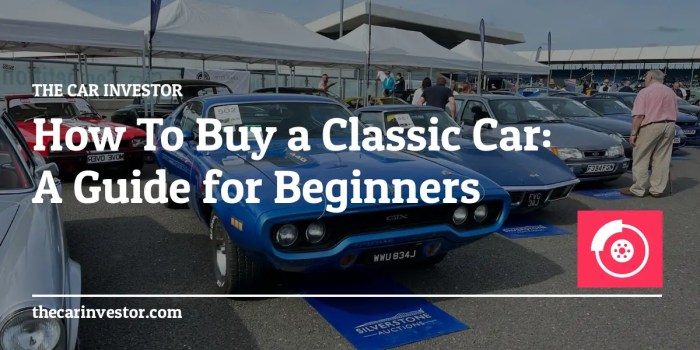How to buy a classic car is a question that stirs the hearts of countless enthusiasts. Whether you’re a seasoned collector or a first-time buyer, navigating the world of classic cars can be both exhilarating and daunting. This comprehensive guide will equip you with the knowledge and strategies you need to make an informed decision and embark on a journey filled with passion, preservation, and timeless joy.
From market research and budget planning to inspection, negotiation, and maintenance, we’ll cover every aspect of the classic car buying process. Along the way, we’ll share expert insights, practical tips, and inspiring stories that will ignite your passion for these automotive icons.
Market Research
Thorough market research is essential when buying a classic car. It helps you understand market trends, identify reputable sellers, and make informed decisions about the value and condition of potential purchases.
Identifying Reputable Sellers
- Dealers:Look for established dealerships specializing in classic cars. Check their reputation, reviews, and inventory.
- Private Sellers:Research online forums, car clubs, and classified ads. Verify their identity, ownership history, and maintenance records.
Factors Influencing Value, How to buy a classic car
- Make and Model:Iconic models and rare makes command higher prices.
- Condition:Restoration, original parts, and maintenance history significantly impact value.
- Mileage:Lower mileage generally indicates better condition and higher value.
- History:Provenance, racing history, or celebrity ownership can add value.
Setting a Budget
Establishing a realistic budget is crucial before embarking on the journey of purchasing a classic car. This budget should encompass not only the purchase price but also the ongoing costs associated with owning and maintaining the vehicle.
Determining the purchase price is the first step. Research the market value of similar classic cars, considering factors such as make, model, year, condition, and rarity. Online resources, classic car clubs, and experienced collectors can provide valuable insights.
Insurance
Classic car insurance premiums vary depending on the vehicle’s value, age, and usage. It is essential to obtain quotes from multiple insurance providers to secure the most competitive rates.
Maintenance
Classic cars require regular maintenance to preserve their condition and ensure optimal performance. This includes oil changes, tune-ups, brake inspections, and potential repairs. The frequency and cost of maintenance will depend on the age, condition, and usage of the vehicle.
Other Associated Costs
Additional costs to consider include registration fees, storage expenses (if applicable), and fuel consumption. These expenses can vary depending on the location and usage patterns.
Financing Options
Financing can be an option for those who do not have the full purchase price available upfront. Classic car loans typically have higher interest rates than traditional auto loans, and the loan term may be shorter. Carefully consider the monthly payments and the total cost of financing before making a decision.
Inspection and Evaluation

Before you commit to buying a classic car, it’s essential to conduct a thorough inspection to assess its condition and identify any potential issues. This process involves examining various components of the vehicle, including the engine, transmission, body, and interior.
A comprehensive inspection can help you make an informed decision about the car’s value and avoid costly repairs down the road. Consider hiring a professional inspector who specializes in classic cars to provide an unbiased assessment.
Further details about Classic car insurance quotes is accessible to provide you additional insights.
Key Areas to Inspect
- Engine:Check for leaks, unusual noises, and proper functionality. Verify the compression and oil pressure to assess the engine’s health.
- Transmission:Test the transmission in all gears, listening for any grinding or slipping. Inspect the fluid level and condition.
- Body:Examine the exterior for rust, dents, or scratches. Check the frame for any damage or repairs.
- Interior:Inspect the seats, dashboard, and carpets for signs of wear or damage. Check the electrical system, including lights, gauges, and switches.
Negotiation and Purchase
Negotiating a fair price for a classic car is crucial to ensure a satisfactory transaction. Before engaging in negotiations, it’s essential to conduct thorough research on the car’s market value, including comparable sales and expert opinions.
During negotiations, approach the process with a cooperative mindset, aiming to find a mutually acceptable price. Be prepared to compromise and consider the seller’s perspective. It’s important to present your offer with confidence and justification, backed by your research.
Handling Contingencies
Contingencies may arise during the transaction, such as the discovery of hidden defects or issues with the car’s history. It’s important to address these contingencies in the negotiation phase. Consider including clauses in the contract that allow for inspections, warranties, or the possibility of withdrawing from the sale if certain conditions are not met.
Importance of a Written Contract
Once an agreement has been reached, it’s essential to have a written contract that Artikels the terms of the sale. This contract should include the purchase price, payment terms, contingencies, and any other relevant details. Both parties should carefully review and sign the contract before completing the transaction.
Transportation and Logistics: How To Buy A Classic Car

Arranging transportation for your classic car is a crucial step in the buying process. You’ll need to consider the distance, the type of vehicle, and the cost.There are several options for transporting a classic car, including:
- Towing:This is the most common and affordable option, but it’s only suitable for short distances.
- Shipping:This is a more expensive option, but it’s the best choice for long distances or if you don’t have a tow vehicle.
- Driving:If the classic car is in good condition and you’re comfortable driving it, you can drive it home yourself.
However, this is only recommended for short distances.
Once you’ve chosen a transportation method, you’ll need to arrange insurance and prepare the car for the journey. Insurance:Make sure you have adequate insurance coverage for the classic car before you transport it. This will protect you in case of an accident or damage.
Preparation:Before you transport the classic car, make sure it’s in good condition and that all fluids are topped off. You should also disconnect the battery and remove any loose items from the interior.It’s important to use a reputable shipping company if you’re shipping the classic car.
Ask for recommendations from friends or family, or read online reviews.
For descriptions on additional topics like Best classic cars to invest in, please visit the available Best classic cars to invest in.
Maintenance and Preservation
Maintaining and preserving a classic car is essential to protect its value and longevity. Regular maintenance, proper storage, and restoration techniques are crucial for keeping your classic car in pristine condition.
Regular Maintenance
Regular maintenance includes tasks such as:
- Oil and filter changes: Change oil and filter regularly, as per manufacturer’s recommendations, to prevent engine damage.
- Brake inspection and service: Check and replace brake pads and rotors as needed to ensure optimal braking performance.
- Tire inspection and rotation: Inspect tires for wear and tear, and rotate them regularly to extend their life.
- Fluid level checks: Check and top up fluids such as coolant, brake fluid, and power steering fluid regularly to prevent leaks and ensure proper operation.
Storage Conditions
Proper storage conditions are crucial to prevent damage and preserve the car’s value.
- Climate-controlled environment: Store the car in a climate-controlled garage or facility to protect it from extreme temperatures and humidity.
- Cover and protect: Use a car cover to protect the exterior from dust, dirt, and UV rays. Place the car on jack stands to prevent flat spots on tires.
- Battery maintenance: Disconnect the battery and store it separately to prevent discharge and extend its life.
Restoration Techniques
Restoration techniques are necessary to repair or replace damaged or worn components.
- Bodywork and paint: Restore the car’s bodywork to its original condition by repairing dents, rust, and repainting the exterior.
- Mechanical restoration: Overhaul or replace the engine, transmission, and other mechanical components to restore the car’s performance.
- Interior restoration: Restore the car’s interior by replacing upholstery, carpets, and other interior components.
Protecting the Car from Damage
Protect your classic car from damage by taking precautions such as:
- Avoid harsh chemicals: Avoid using harsh chemicals or detergents when cleaning the car to prevent damage to the paint and finish.
- Limit exposure to the elements: Minimize the car’s exposure to rain, snow, and excessive sunlight to prevent corrosion and fading.
- Install security measures: Install an alarm system and immobilizer to deter theft and vandalism.
Enjoying the Experience
Owning and driving a classic car is not just about possessing a piece of automotive history; it’s about experiencing a unique blend of nostalgia, passion, and community. From the moment you slip behind the wheel of your classic ride, you’re transported to a different era, where the sights, sounds, and smells evoke a sense of timelessness.Every drive becomes a journey, an opportunity to connect with the past and appreciate the craftsmanship and engineering that went into creating these automotive icons.
The mechanical simplicity of classic cars allows you to feel a direct connection to the road, engaging all your senses and making every drive an unforgettable experience.
Joining Car Clubs and Participating in Events
The classic car community is a vibrant and welcoming one, with countless car clubs and organizations catering to every make and model. Joining a car club provides a wealth of benefits, from technical support and advice to organized events and social gatherings.Participating in classic car events, such as rallies, shows, and concours, is a fantastic way to connect with fellow enthusiasts, share your passion, and admire a wide variety of classic cars.
These events are a celebration of automotive heritage, where you can learn about the history of different models, witness stunning restorations, and make lasting friendships.
Passion and Camaraderie
Classic car enthusiasts are a passionate and dedicated group, united by their love for these timeless machines. They spend countless hours restoring, maintaining, and driving their classic cars, often forming deep bonds with their fellow enthusiasts.Stories abound of classic car owners who have traveled great distances to attend events, helped stranded fellow drivers, and shared their knowledge and expertise with others.
The camaraderie among classic car enthusiasts is a testament to the enduring power of these automotive icons and the passion they inspire.
Last Point

Buying a classic car is not merely a transaction; it’s an investment in a piece of history, a symbol of automotive excellence, and a gateway to a community of passionate enthusiasts. By following the steps Artikeld in this guide, you’ll not only acquire a classic car but also embark on a journey of preservation, appreciation, and unforgettable experiences.
So, whether you’re seeking a pristine collector’s item or a cherished daily driver, let this guide be your compass as you navigate the world of classic cars and discover the timeless joy of owning a piece of automotive history.